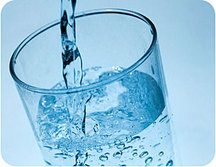
The World Health Organization
The World Health Organization (WHO), set up some guidelines for drinking-water quality which are the international reference point for standards setting and drinking-water safety. The latest guidelines drew up by the WHO are those agreed to in Geneva, 1993.
Click here for the WHO's drinking-water standards.
You will notice that there is no guideline for some of the elements and substances which are taken into account. This is because there have not been sufficient studies about the effects of the substance on the organism, and therefore it is not possible to define a guideline limit. In other cases, the reason for a non-existing guideline is the impossibility of that substance to reach a dangerous concentration in water, due to its insolubility or its scarcity.
The European Union
The European Union drew up the Council Directive 98/83/EC on the quality of water intended for human consumption, adopted by the Council on 3 November 1998. This was drawn up by reviewing the parametric values of the old Drinking Water Directive of 1980, and strengthening them where necessary in accordance with the latest available scientific knowledge (WHO guidelines and Scientific Committee on Toxicology and Ecotoxicology). This new Directive provides a sound basis for both the consumers throughout the EU and the suppliers of drinking water.
Click here for the EU's drinking water standards.
These were the main changes in the parametric values:
- Lead: The guideline was reduced from 50 µg/l to 10 µg/l, and a transition period
of 15 years was defined to allow replacing of lead distribution pipes.
- Pesticides: The values for individual substances and for total pesticides were
retained (0.1µg/l / 0.5µg/l), plus additional, more stringent values were
introduced for certain pesticides (0.03µg/l).
- Copper: The value was reduced from 3 to 2 mg/l.
- Some new standards were introduced for new parameters like trihalomethanes,
trichloroethene and tetracholoroethene, bromate, acrylamide etc.
source : lenntech.com
The World Health Organization (WHO), set up some guidelines for drinking-water quality which are the international reference point for standards setting and drinking-water safety. The latest guidelines drew up by the WHO are those agreed to in Geneva, 1993.
Click here for the WHO's drinking-water standards.
You will notice that there is no guideline for some of the elements and substances which are taken into account. This is because there have not been sufficient studies about the effects of the substance on the organism, and therefore it is not possible to define a guideline limit. In other cases, the reason for a non-existing guideline is the impossibility of that substance to reach a dangerous concentration in water, due to its insolubility or its scarcity.
The European Union
The European Union drew up the Council Directive 98/83/EC on the quality of water intended for human consumption, adopted by the Council on 3 November 1998. This was drawn up by reviewing the parametric values of the old Drinking Water Directive of 1980, and strengthening them where necessary in accordance with the latest available scientific knowledge (WHO guidelines and Scientific Committee on Toxicology and Ecotoxicology). This new Directive provides a sound basis for both the consumers throughout the EU and the suppliers of drinking water.
Click here for the EU's drinking water standards.
These were the main changes in the parametric values:
- Lead: The guideline was reduced from 50 µg/l to 10 µg/l, and a transition period
of 15 years was defined to allow replacing of lead distribution pipes.
- Pesticides: The values for individual substances and for total pesticides were
retained (0.1µg/l / 0.5µg/l), plus additional, more stringent values were
introduced for certain pesticides (0.03µg/l).
- Copper: The value was reduced from 3 to 2 mg/l.
- Some new standards were introduced for new parameters like trihalomethanes,
trichloroethene and tetracholoroethene, bromate, acrylamide etc.
source : lenntech.com
 RSS Feed
RSS Feed